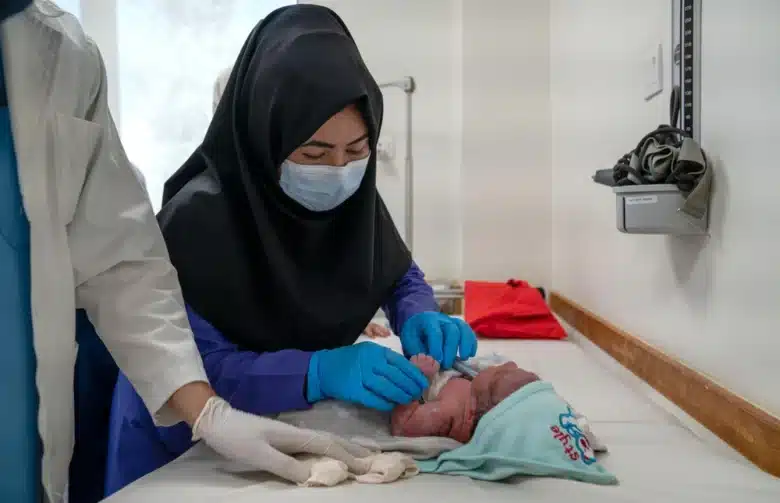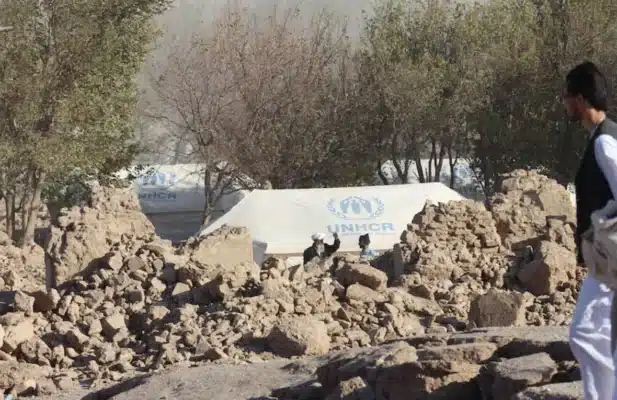
Midwife students participate in practical training sessions at Bamyan’s Provincial hospital. © UNHCR/Oxygen Empire Media Production
In remote rural villages, difficulties in reaching health services and trained health staff are life-threatening for mothers and their infants
By Caroline Gluck in Bamyan province, Central Highlands, Afghanistan
Speaking from her one-room, mud-built house in the beautiful but remote village of Qala-e-Jaroo, high in the Qazan Valley, in Afghanistan’s Bamyan province, mother-of-two Rahela calmly recounts how she lost her third child due to a miscarriage a few months earlier.
The 24-year-old woke in the middle of the night with contractions and bleeding, six months into her pregnancy. She knew that she needed to get help. But with no village midwife, she and her family had to make their way to the nearest health clinic, around two hours away. First, she had to climb down steep mountain paths from the village to reach the road. When the car they had called did not arrive, they had to keep walking.
“I had a lot of pain and bleeding,” said Rahela. “My baby died in my womb because we walked a lot of the way.”
At the clinic, staff informed her that her baby was dead and that she should go to the provincial hospital, several hours away on foot.
Stories like hers are, unfortunately, not uncommon in the rugged, mountainous provinces of Bamyan and Daikundi, especially during the harsh winter months when heavy snowfall and avalanches can cut off villages from roads and services for months at a time. Afghanistan has one of the world’s highest child and maternal mortality rates. In 2020, the World Health Organization estimated that 24 Afghan women died every day in childbirth or pregnancy.
The young midwife trainees taking part in a two-year diploma programme supported by UNHCR, the UN Refugee Agency, are all too familiar with cases like these.
In a classroom in Bamyan city, where the women are studying, 22-year-old trainee, Masoma, describes how her seven-months pregnant mother lost her baby several years earlier while attempting to reach a hospital in the winter.

Student midwife Masoma performs checks on a newborn under supervision at the hospital. © UNHCR/Oxygen Empire Media Production
She slipped on ice trying to reach a road, breaking her wrist, and cutting her leg, and began bleeding heavily from her finger and thigh. “Men had to move my mother onto a wheelbarrow, and it took eight or nine hours before she reached the hospital,” she said.
“My mother lost my brother in her womb. She lost her finger,” said Masoma. “She was very weak because she lost too much blood. She nearly lost her life, and she was hospitalized for one month.”
From that moment on, said Masoma, who was still at school at the time, she was determined to prevent similar situations from happening to others. “I study with passion and enthusiasm. I want to become a person to serve my community.”
Golden opportunity
The 80 women taking part in the midwife programme are from poor families and remote communities. They are all highly motivated; not least, because this training is one of the few opportunities still available for Afghan women to continue studying, since it falls under the health sector which is exempted from bans introduced by the Afghan de facto authorities in 2021, barring women from many areas of work and from attending school or university after Grade 6.

Shukria (left) and other trainee midwives attend classes. © UNHCR/Oxygen Empire Media Production
“It is a golden opportunity for the girls to be able to continue to study, to play an active role in society and serve the community,” said Najiba Ahmadi, field officer with UNHCR’s partner, WSTA (Watan Social and Technical Service Association), which runs the midwifery programme.
She said that when the project was first announced, they were inundated with applications. “Even now, every day, hundreds of girls come to the office asking if we have another programme so they can participate.”
Unacceptable losses
The good news is that UNHCR plans to run another two-year programme in the two provinces next year and is hoping to start similar courses in other provinces next year.
But there is still a long way to go to bring down Afghanistan’s unacceptably high mother and infant mortality rates. A beautiful hand-stitched picture hanging in Bamyan’s provincial hospital, where the midwife trainees are now learning practical skills, shows a woman being carried on wooden stretchers by two men, after she died in childbirth while trying to reach the nearest hospital, 120 kilometres away.
Back in Qazan village, Rahela, who lost her third child, chats to Shakira, one of the midwife trainees, who is from the same village. “If we can have midwives like Shakira here, then things will be good and we will be happy,” she said. Her husband, Ahmad, a farmer, nodded in agreement. “If there are more doctors and clinics in the community, the problems of women will get solved sooner.”
For 22-year-old Shakira, this home visit only strengthens her resolve to return to the community as a fully trained midwife.
“Whenever I come to the village and see mothers like Rahela, I’m motivated to work harder and study more, so I can become a good midwife and prevent the deaths of mothers and children,” she said.
Originally published by UNHCR on 25 October 2023.





